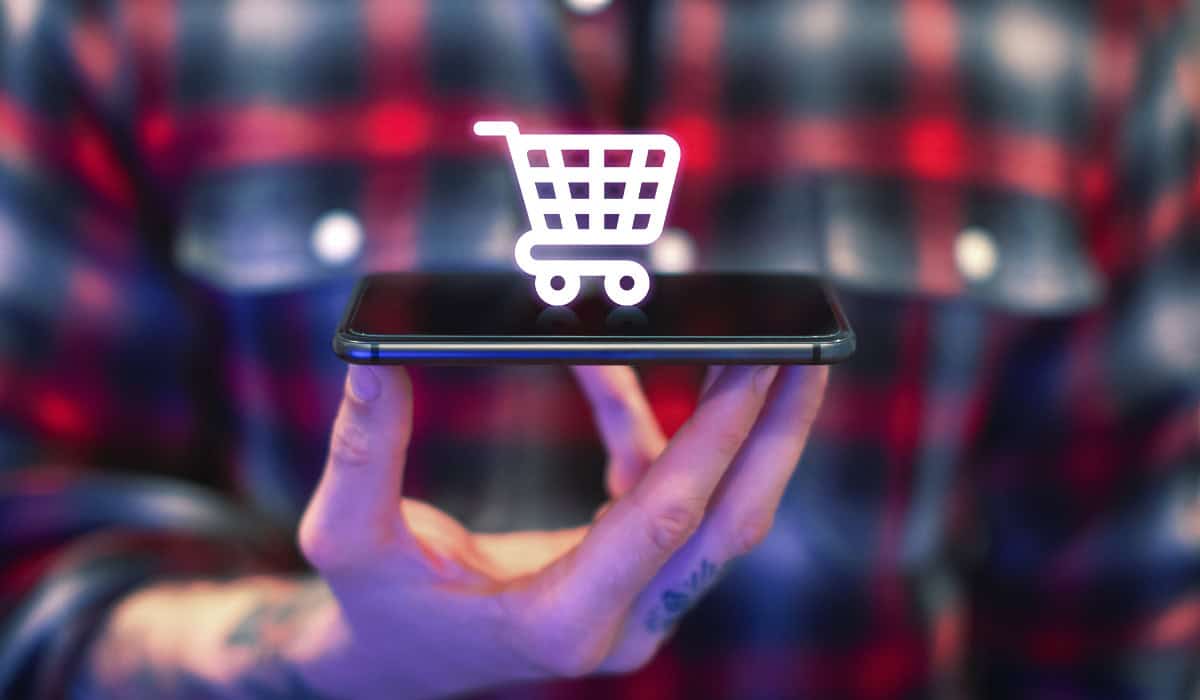
©Marco_Piunti via Canva.com
August 22, 2024
How Will Mobile Commerce Change Retail?
According to Adobe Analytics, mobile shopping, also called m-commerce, is projected to drive 53% of online sales during the upcoming holiday season. This data profiles the “slow but steady shift in consumer demand for shopping on smaller screens.”
Adobe reported that during the first few months of 2024, mobile spending consistently grew in the double digits, bringing it on par with desktop shopping. The report stated, “At this trajectory, Adobe sees a tipping point in the months ahead.” This comes after mobile already beat desktop shopping last November and December, but Adobe expects even more growth this year, and it also forecasts that “mobile shopping will consistently eclipse desktop” in 2025 outside of the holidays.
Per Statista, “In the first quarter of 2024, smartphones accounted for over three-quarters of retail site visits in the United States and generated roughly two-thirds of online shopping orders.” In comparison, desktop computers accounted for only 23% of retail website traffic but were responsible for 34% of all purchases in the country.
In November 2022, Pew Research shared that 32% of U.S. adults said they bought things online with their smartphones at least weekly, compared to 21% who said the same for their computers and 7% for shopping on tablets.
Now, Adobe has reported that mobile share of online sales rose on a year-over-year basis every single month this year, accounting for 46.7% of online sales in January 2024 and 49.3% in July 2024.
Yet this still leaves room for growth. According to research by software company Quantum Metric, although many consumers use their phones to browse and research products — spending 20% more time on mobile in 2024 compared to the previous year — only 47% of monthly online sales are completed via mobile. The disparity is particularly notable in sectors like travel and financial services, where mobile purchases are even less prevalent.
Furthermore, mobile devices are integral to our digital lives, generating 73% of monthly traffic across various industries. Despite this high engagement, mobile commerce has not yet achieved its full potential.
The challenge lies in converting mobile browsing into actual sales. While 75% of consumers browse on mobile devices multiple times a day, only 26% make purchases through their phones daily. Factors contributing to this gap include a lack of confidence in mobile transactions for higher-value items, with only 17% feeling secure making purchases over $250.
Additionally, around half of mobile users experience slow performance, bugs, app crashes, and payment failures. Good, reliable performance is critical with consumers who attempt mobile transactions since “they want their experiences to be quick. In fact, most users expect mobile transactions to take 3-5 minutes. Any longer and 55% would abandon,” as reported by Quantum Metric.
One of the biggest boons to mobile commerce has been from social media. Pew Research noted how social media influencers significantly impact buying decisions, with 30% of adult social media users reporting they have purchased items after seeing influencer posts. This influence is even stronger among those who follow influencers, with 53% making purchases based on these posts. Women are more influenced than men, with 36% of female users buying items after seeing influencer content compared to 21% of males. Younger users are also more affected, with 41% of adults under 30 making purchases based on influencer posts.
Emarketer cites additional challenges that mobile commerce faces. According to the market research company, “It’s becoming increasingly challenging to acquire new mobile app users. Temu and SHEIN disrupted the market last year with explosive user growth, intensifying competition in the retail app market.”
“Temu and SHEIN have a newcomer advantage. But they are also focusing on the mobile shopper because they understand that that’s the future of e-commerce. U.S. retailers, which have been in business longer, have apps but are not trying to scale as aggressively.”
Blake Droesch, Emarketer Analyst
In general, consumers are downloading new apps at a decreasing rate that’s expected to see dramatic decreases until at least 2027. The company also cited data from Adjust, which explained that retention is another challenge due to the high bounce rate of users who abandon e-commerce apps within a week of downloading them.
Ultimately, mobile commerce offers significant benefits but also comes with challenges. On one hand, it provides convenience, allowing users to shop anytime and anywhere, which is advantageous given the time people spend on their phones. However, many apps have friction points, such as a lack of payment flexibility, that could send shoppers elsewhere. Additionally, some users have security concerns on mobile, and others noted a lack of tools compared to desktop shopping, according to Quantum Metric.
For retailers, mobile commerce caters to the desire for instant gratification, and a well-designed mobile commerce experience can boost customer retention. However, mobile commerce faces hurdles such as the need for continuous optimization to keep up with evolving technology.
Discussion Questions
What strategies can retailers use to improve app acquisition and retention in a challenging mobile landscape?
Considering the impact of social media and influencers on consumer buying behavior, how should retailers refine their mobile commerce strategies to leverage these platforms effectively?
How can retailers bridge the gap between high mobile traffic and low conversion rates?
Poll
BrainTrust
David Spear
President, Retail, OrderlyMeds
Bob Amster
Principal, Retail Technology Group
Lucille DeHart
Principal, MKT Marketing Services/Columbus Consulting
Recent Discussions







I think mobile commerce has already changed retail. The shifts have happened. But still, my biggest complaint about mobile shopping is sites that are not optimized for smaller screens. It makes navigation, viewing products, and functions like checkout very difficult. This is one of the reasons I actually prefer shopping via an app when on mobile. It is just a much more streamlined process. I also like things like payments to be integrated because mobile shopping is often done while on the move when you don’t want to be hunting around for credit card numbers and so forth. As you’d expect, retailers like Amazon, Target and Walmart do this very well.
I totally agree with your comment about sites not optimized for mobile screen sizes. Whenever I have a disappointing experience navigating or viewing products on a retailer’s website, my perception of the brand is tarnished and I usually abort my shopping. Many companies have touted the strategy of “mobile first” but I don’t think they all “walk the talk.” Mobile retail websites still have room for improvement and the quality of the customer experience has a direct impact on satisfaction and loyalty.
Exactly this, David. If the experience is too frustrating, I simply navigate away as I can’t be bothered to interact with the site!
Mobile commerce will grow exponentially as social media and streaming media sites add more shoppable commercials. Retailers should prepare themselves.
Hasn’t it already?!? Don’t we all have our go-to apps from which we shop? Getting people to download your app is the like the competition retailers have for getting people in their stores, on their website and the experience we have is what makes us stay or go.
Mobile commerce = convenience. Ten years ago, we were having conversations about mobile and e-commerce putting retail stores out of business. That conversation continues and rather than talk about them going out of business, talk about the change that’s occurring. There is a balance that continues to lean more toward online, apps, and mobile. Retailers must embrace the buying behaviors of consumers worldwide.
Mobile has already changed retail. Look for qualities that distinguish retail winners from retail laggards and mobile will be one of those criteria! The fact is, consumers are not running around planning their lives around how they shop with retailers for products they need or want. Consumers are simply going through their everyday life and in the moment when they realize they need or want something, they reach for the most convenient method they have access to in that moment to help them make a buy decision. Quite often that will be their mobile device.
Continuing with this convenience theme, I argue that mobile apps are far superior to mobile web experiences in this regard, but there is one important caveat here. Thew typical consumer will not download an app for every retailer they buy from. We can assume consumers will keep on their smartphone only the apps from retailers they frequent the most and that provide the most value from that app. This is likely no more than 2 or 3. After that, consumers will infrequently experience a retailers mobile web site. This is why retailers must design for both, and should accept that their most loyal customers will be using the app vs the mobile web. It’s up to the retailer to establish a unique value form the app to convert those infrequent buyers into loyal customers, be it through a loyalty rewards program or simply the most desirable search capabilities in the app that help the customer find what they want without having to resort to a search website or alternate retailer.
The rise of M-Commerce has already had a significant impact on retail, as well as how consumers shop. The e-commerce sector is the one that should be concerned with mobile commerce.
Each year, over 100 billion hours are spent on e-commerce applications. In the absence of a change to accommodate m-commerce, conventional e-commerce websites risk becoming obsolete.
For the purpose of discussion, m-commerce must, like e-commerce, be categorized.
There are Marketplace Apps like Amazon and eBay, Brand Apps like Nike and Zara, Multi-Brand Retail Apps like Target and ASOS, Grocery Apps like Instacart and Shipt, Buy and Sell Apps like Poshmark and Offer Up, Coupon, Deal, and Cashback Apps like Rakuten, Groupon, and Capital One Shopping.
Among the benefits of m-commerce are enhanced metrics for measuring customer interaction, such as the amount of time spent in the store, conversion rates, and products viewed, increased recurring business and repeated visits, a direct connection to your customers by push notifications, an enhanced and more practical shopping experience, and app store listings provide additional signals of trust and offer a strong channel for acquisition.
A wide range of industries utilize mobile commerce applications, including Health and Beauty, Supermarkets, Drug stores, Mass merchants, Sporting goods, Electronics and entertainment, Home improvement, Restaurants, Apparel, Hobby and Craft stores, Department stores, and Home goods.
In any type of technology or business, some applications work extremely well, some are good, some are mediocre, and some require significant improvement.
Examples of well-working applications include Amazon, Walmart, Target, Temu, Shein, Etsy, Nike, Zara, ASOS, Instacart, Poshmark, Offer-Up, Rakuten, Stocard, and Groupon.
The role of mobile commerce in digital retail will continue to grow as well as become increasingly integrated with brick-and-mortar retail. We are rapidly approaching the point where the dynamics and integration between each channel are essential. Db
I am reminded of guidance from a marketing professor. He said to look around the room and know that we would be marketing to no one in the room. No one we know.
Mobile is the only computer for a large percentage of the population. Delivering a high quality mobile commerce experience not only benefits users with device options, it’s critical to those whose cell phone is their only computer.
As more brands add shoppable content to social media, both the brands and platforms need to reduce sources of friction that prevent conversions. Build trust and drive sales by reassuring shoppers the site is secure. Provide a clear delivery date as well as any fees.
While I’ve discovered products on Instagram, the late delivery and high fees led me to buy the items on Amazon instead.
Mobile has become the first screen for a high majority of consumers and shopping on the device will only continue to increase. Retailers must have a mobile first strategy or they will put themselves in danger of losing eyeballs and transactions. This includes constantly looking through the lens of the user, the shopper, to understand their needs, wants and desires. I’d advise retailers to engage in a design thinking methodology to reimagine the art of possible and build an app that’s user centric, delivering an elegantly simple experience loaded with value and utility.
Assuming that shopping across all channels is a zero-sum game, mobile commerce will not increase purchases but shift them from all other channels to mobile. The change is fueled by changing demographics. Many consumers have grown up with a mobile phone in their hands and membership in multiple social media. That demographic will grow in number. Retailers need to make their mobile commerce apps easy to use, fit elegantly in a relatively small screen, and the purchase easy to pay, with multiple tender types accepted.
Exactly, Bob. Mobile shopping is way too difficult for me, but it is a no-brainer for my grandkids.
“I’m so old that my blood type is discontinued.” – Bill Dane
Mobile’s share of ecommerce has steadily increased and accounts for over half of ecommerce sales. However, globally, ecommerce still accounts for only 16% of total, global retail sales. Mobile is becoming the big fish in the little pond but it has a long way to go. There’s no getting around the limited space of a phone and that will continue to be a challenge along with all the others already mentioned. Retailers should prepare by understanding what purchases (like repeat purchases) and what products are most mobile commerce friendly and optimize those experiences and journeys. But the game remains in the “big pond” where ecommerce has yet to live to its expectations.
User experience needs to be the top priority for m-commerce. Retailers still seem to have a desktop first approach to digital experiences other than social media engagements. The focus should be how to streamline the conversion journey and make search and shopping more mobile friendly–especially with regard to screen space and page design. Payment integration will also be critical and should not rely only on app use for one-click check out. Companies like Bolt are helping with that.
Retailers need to stop just chasing app downloads and focus on delivering value that keeps users engaged. Improving app retention demands seamless user experiences—fast load times, reliable payments, and personalized content.
Leveraging social media and influencers is crucial, but only if tied to clear, direct calls to action that drive mobile conversions.
To bridge the gap between high mobile traffic and low sales, retailers must simplify checkout processes, especially for high-value purchases. Infact, the mobile experience should be so good that users won’t want to shop anywhere else.
I suspect the phone as a purchasing tool trends higher as you go down the age curve. Further, the “app gold rush” is over–there are too many apps chasing too little real estate on our screens. And finally, so many web sites are not optimized for mobile.
Mobile has already had an oversized impact on retail and we are now at a stage of incremental adjustments and improvements in the user experience, while older demographics age out of our usage due to the smaller screen size and failing eyesight.
While mobile commerce is gaining popularity, there’s still a significant gap between mobile browsing and actual purchasing, especially for higher-value items where confidence in mobile transactions can be lacking. A multi-channel approach that combines the strengths of mobile and in-store shopping can help bridge this gap, particularly for high-value items that may be secured in-store. This approach offers greater convenience than traditional in-store shopping and delivers a more integrated shopping experience for consumers.
What a lot of retailers overlook is the importance of the mobile website experience. As mentioned, customers won’t download an app for every retailer they buy from without a level of loyalty and customer benefit in doing so. Depending on the retailer, the mobile website can be more important.
Depending on the category, if customers are browsing on mobile and converting in stores or elsewhere, then mobile is doing its job. This can be hard to directly measure so its important for retailer to understand the path to purchase for their customers.